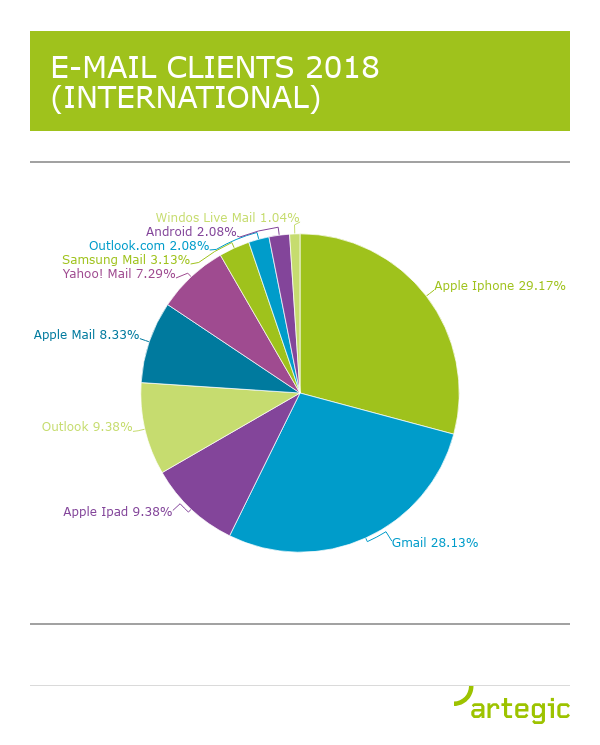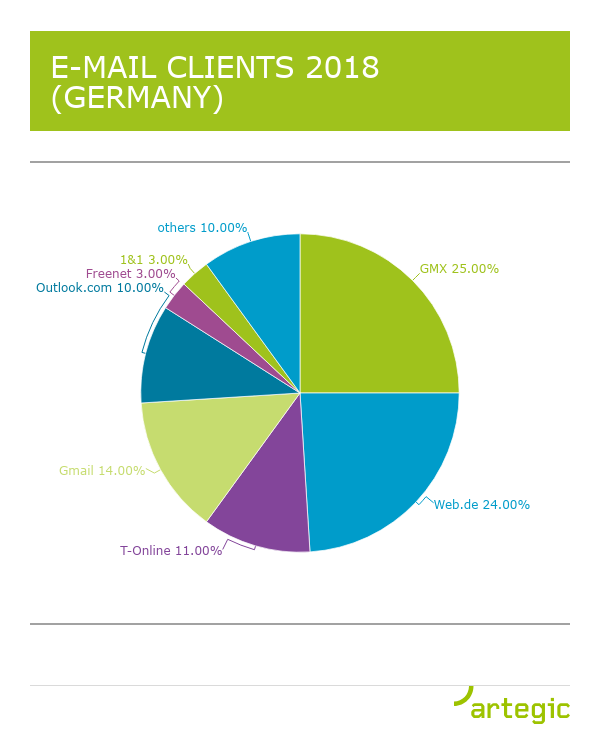Email marketing is and remains one of the most efficient and promising channels through which companies communicate with prospects and customers. The email landscape is constantly changing: new clients and operating systems are emerging, existing ones are changing and expanding, others are disappearing. The fluctuation on the market and the rapid changes in the various clients are primarily due to changes in customer needs and expectations, which require adaptation on the part of the industry and previous standards.
The Litmus Report 2018 deals with relevant client developments from the year 2018 and trends for the current year.
Which client giants are there and what influence do they have on the market?
Currently, Apple’s “Apple iPhone” and Google’s “Gmail” clearly dominate the market with a share of 29 percent and 27 percent, respectively. But even beyond these two giants there are interesting changes that are also reflected in the shift in market share. Outlook opening rates are rising steadily – in 2018 this email client was able to achieve a market share of 8%, 2% more than in the previous year. And the infrastructural merger of AOL and Yahoo! mail clients is currently responsible for 6% of all email openings.


The boom in email marketing can largely not be attributed to new email clients on the market, but rather to updates and releases to adapt different platforms to different ecosystems and create the best possible user experience with ease of use, customization and personal preferences.
The mobile sector is one of the most significant market developments in recent years, accounting for 43% of all email openings. The opportunities this trend brings with it are explained in more detail below.
Updates, releases, and trends
Future developments will be oriented primarily towards innovations in market-leading email clients. Especially Gmail, Outlook, Apple’s iPhone as well as AOL and Yahoo! show which trends, but also challenges, will determine the daily business of email marketers.
- Although the Outlook mail client offers no new surprises, client developments correspond clearly with current trends in the digital world. For example, the “Read Aloud” function not only makes it easier to use all users, but also opens the door to integration with Smart Assistants, which, according to forecasts, will increase to around 250 million installations by the end of this year. Outlook also demonstrates adaptability in the mobile context through so-called CSS Media Queries, through which campaigns and mailings can be optimized independently of the end device, for example by adjusting file sizes and image resolutions. Completely new releases of the client include above all the introduction of the “Focused Inbox”, which prioritizes mailings individually for a user and arranges them according to relevance in the mailbox. In contrast to a spam folder, this function is not just intended to filter out spam, but rather to help the user to organize the flood of mailings in the mailbox and thus make it more accessible again for news about his favourite brands. And a small ray of hope for all typography lovers: Outlook no longer uses Times New Roman as a fallback font.
- In contrast to the innovations in Outlook, the number 1 among email clients, Apple’s iPhone, relies especially on the visual change of the client as a whole. In this sense, the so-called “dark mode” was introduced, i.e. a darker user interface for all windows and menus. This mode also adjusts the background color in plain text emails to the darker hue. However, HTML emails remain unchanged, so dark mode does not pose a threat to individual mailing codes. However, the mode has one crucial point: Unfortunately, users of the dark mode cannot be directly targeted in order to send a version of the mailing optimized for the dark mode. The optimization of the mobile view of a mailing is also central for Apple’s mail client: media queries are intended primarily to benefit new iOS end devices with larger screens and higher screen resolutions.
- Gmail has already implemented several updates and releases. These include in particular support for AMP, an open source technology that improves and optimizes the performance of web content on mobile devices. In the mobile context, Gmail is thus a pioneer for a new level of interactivity in mailings. Another innovation is the so-called “Promotion Tab“, which allows marketers to insert additional information, action codes or images into the preview of a mailing in the mailbox. This is intended to increase the visibility, relevance and value of a mailing. The selection and combination process of the promotion is to be supported by machine learning. Another update from Gmail are the “Unsubscripe Suggestions”, which suggest opt-outs based on certain hints, such as the frequency of a mailing. Last but not least, there are news in the release area: Gmail releases “Gmail Go”, a simplified, light version of the traditional app.
- Last but not least, there are interesting changes to the email clients of the so-called “Oath Umbrella”, consisting of AOL and Yahoo! By merging the infrastructures, both clients now have the same Message Transfer Agent, which allows email tracking tools to document mailings from these providers in summary. A special update of the AOL and Yahoo! clients is image caching, a method that makes it possible to load images in emails not from the sender’s servers, but from the original proxy server. This makes the analysis of mailings considerably more difficult for marketers. Especially the tracking of pixels is affected, as well as the specification of the geolocation. Another point is that the reliability and accuracy of individual mailings with dynamic content is reduced.
Bottom line
Email clients are competing for market share and there is a flood of innovation. As an email marketer you should keep an eye on all relevant clients and get the most out of the available innovations and releases. Email marketing is becoming more efficient and more focused on the visual and interactive side than on text-based marketing, offering so much potential to get the best out of all clients to get the most out of their products.